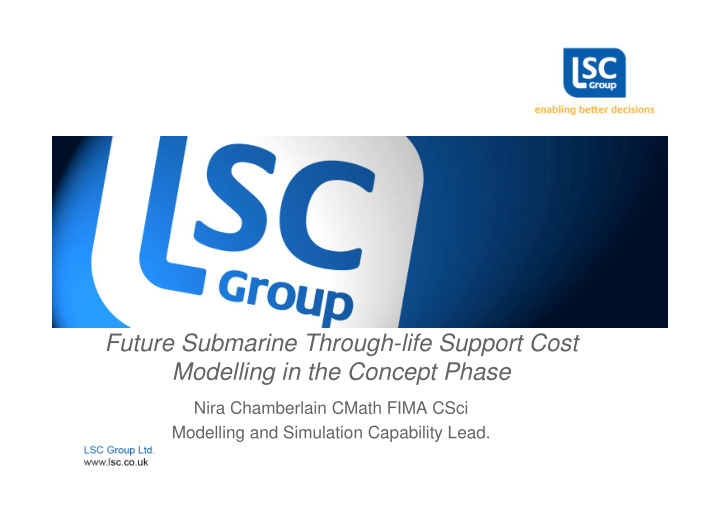



Future Submarine Through-life Support Cost Modelling in the Concept Phase Nira Chamberlain CMath FIMA CSci Modelling and Simulation Capability Lead.
LSC Group LSC is a Consultancy and We work closely with clients LSC is a Consultancy and We work closely with clients Systems Integration services to enhance their decision- Systems Integration services to enhance their decision- company making capabilities company making capabilities Our mission is to make Our mission is to make …enabling better decisions …enabling better decisions complex decision-making complex decision-making throughout the asset life throughout the asset life informed, precise and informed, precise and cycle cycle collaborative ….. collaborative ….. 200 people across 4 key Defence market focus across 200 people across 4 key Defence market focus across locations and numerous Maritime, Air, Land & MoD locations and numerous Maritime, Air, Land & MoD customer sites centre customer sites centre
Modelling and Simulation roles • LSC Groups Modelling and Simulation Lead • Future Submarine Design for Minimum Cost Manager • Concept phase investment appraisal through life cost studies for systems selection.
The Problem • Most of the problems within the concept phase of a project are messy and complex, often entailing considerable uncertainty
The Challenge • Because of the nature of the project the cost team were being asked Demonstration Phase style questions within the concept phase. • It was widely believed that there is a relatively small window in which significant whole life cost savings can be engineered into the boat .
Window of Opportunity • This is due to the well known fact that 75-80% of the cost of a product is determined during the design phase. Cumulative Life Cycle Committed Costs Incurred Costs Cost Concept Assessment Demonstration Manufacture In Service
Traditional Approach • “Wet finger in the air” • Cost estimates based on physical characteristics.
Issues with traditional approach • In terms of “Wet finger in the air” • The assumptions become the solution. • A guess will always be replaced with a guess.
Issues with traditional approach • In terms of cost estimating based on physical characteristics; finding significant cost deltas between the options proved to be problematic.
The Approach • Recognise that we are being asked different questions • Instead of bending the client to fit the model, we have to develop the model(s) to fit the client.
Modelling Philosophy • A “guess will always be replaced by a guess but a logical argument evolves”
Guess Guess Guess Guess Concept Design Design Concept Concept Logical Logical Logical Logical Argument Argument Argument Argument
Addressing the Challenge:
Addressing the Challenge: What are the cost consequences of the design characteristics?
Logical Argument Based Model • LABM uses advanced quantitative methods, modelling, problem structuring, analytical techniques to examine assumptions, facilitate an in - depth understanding and from this develop a practical solution which is transparent and challengeable.
Addressing the Challenge:
Another challenge • What happens when the client ask about maintenance cost of a system that never existed on the previous platform?
Modelling Philosophy • A “guess will always be replaced by a guess but a logical argument evolves”
Addressing the Challenge:
Addressing the Challenge:
Addressing the Challenge:
The challenge • How can we relate cost to performance and requirement?
Case Study Demonstration:
Other Bespoken Cost Models 1. The Dynamical Probability Analysis Tool. – Rapid fire but robust Monte-Carlo Simulation Tool. 2. The Spend to Save Model – Measure the effectiveness of cost reduction strategies. 3. Heuristic Engineering Analysis Tool – Captures the Engineering Impact of costed solutions .
Integrating models into a suite of tools LABM DPAT CPTO HEAT MM Simulation
Conclusion • In the concept phase if the client ask you Through Life demonstration phase style of questions; it is better to adapt your model(s) to the client than trying to adapt the client to the models. • A guess will always be replaced by a guess but a logical argument will always evolve.
References R equirements GD Bowman CDRS hosting and support services P lanning I mplementation M anagement
Recommend
More recommend